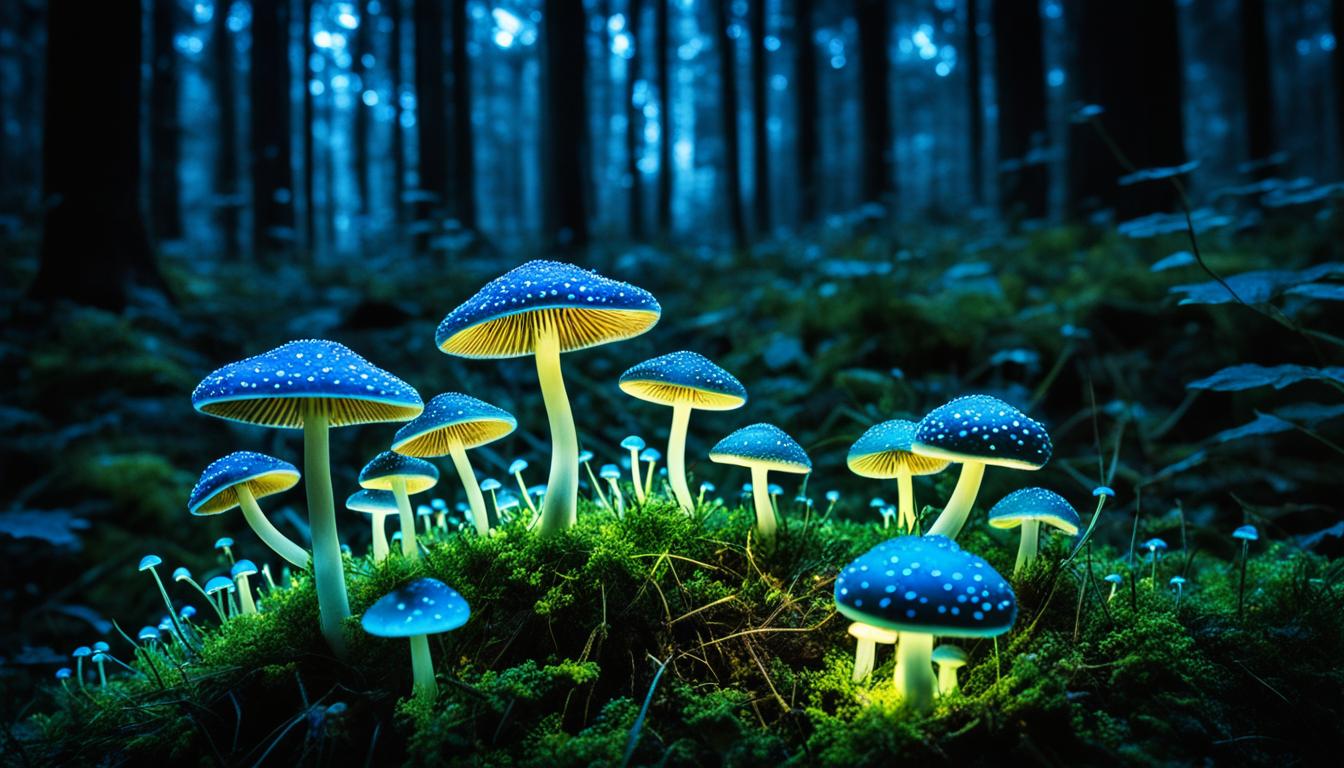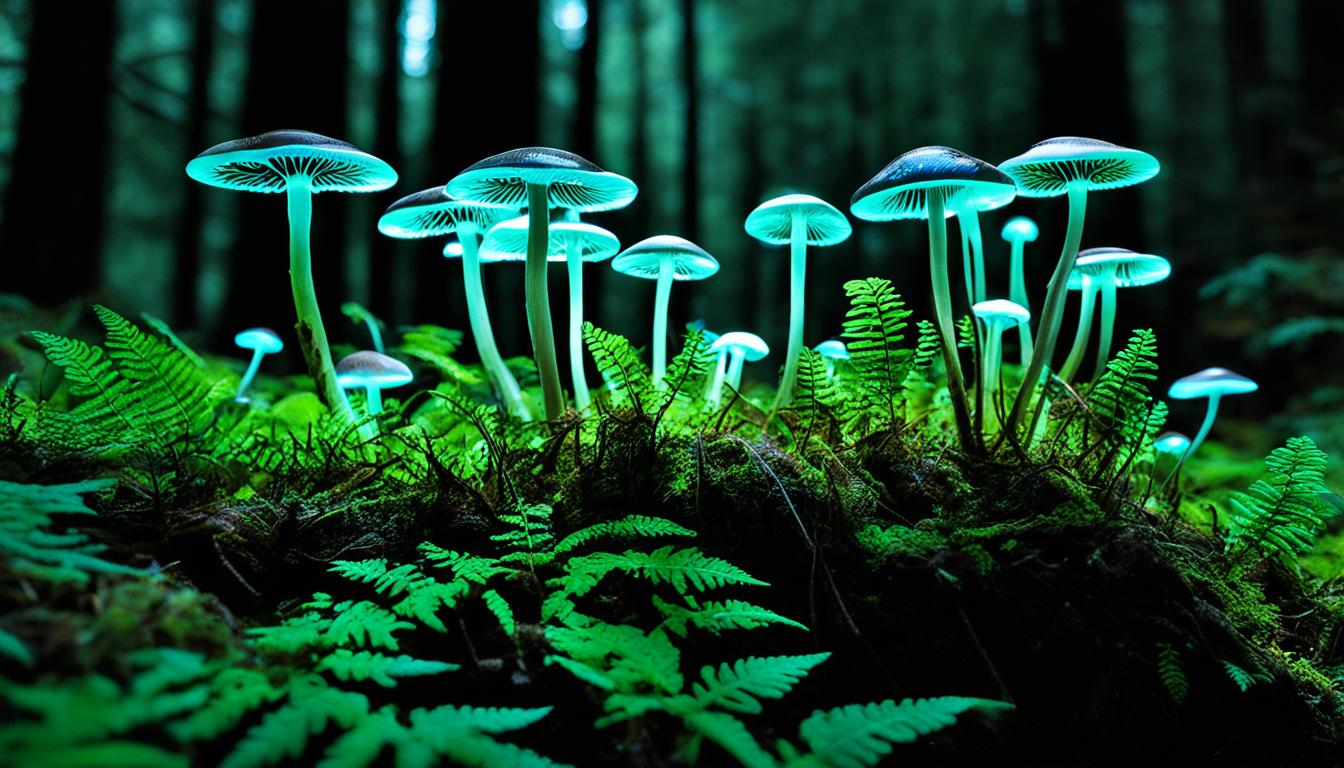Did you know bioluminescent mushrooms are a rarity in the wild? Only a few species have been found. Among them are the honey mushroom (Armillaria mellea), the jack-o’-lantern mushroom (Omphalotus olearius), and Mycena chlorophos. These amazing fungi light up the dark, moist places they live in. Their light can be greenish-yellow or bright blue. When you learn about bioluminescent fungi, you discover the beauty of nature. You also find out how important they are to our environment. This article will show you the beauty, science, and importance of these glowing mushrooms.
Key Takeaways
- Bioluminescent fungi emit light primarily seen in dark, woody environments.
- Notable species like Armillaria mellea can be found across multiple continents.
- The glow may attract insects for spore dispersal or deter potential predators.
- These fungi play a vital role in various ecosystems, enhancing biodiversity.
- Future research aims to explore their applications in eco-friendly lighting solutions.
- Conservation is crucial to protect these unique organisms from habitat loss.
The Magic of Bioluminescence
Bioluminescence is a marvel that lights up nature. It happens in fungi and other organisms through a special chemical reaction. This reaction between luciferin and luciferase makes a beautiful glow. It does this with little heat, creating the magic we see in glowing fungi.
Around 50 types of creatures have developed bioluminescence on their own. For example, about 70 kinds of glowing fungi exist worldwide. This includes Panellus stripticus, which you can find in many places. The way bioluminescence shows up in so many life forms adds to its mystery.
In the ocean’s depths, bioluminescence is even more stunning. Creatures here use their glow for protection. They blend into the light, hiding from predators. There’s also the astounding milky sea effect. It happens when certain ocean creatures light up, like a natural alarm system.
But bioluminescence isn’t just pretty to look at in fungi. It has a purpose. The glow from mushrooms attracts animals that help spread their spores. So, this beautiful light ensures their survival. By exploring these glows, we learn about life’s connections and the science behind them.
| Aspect | Details |
|---|---|
| Number of Independent Evolutions | Approximately 50 |
| Species of Bioluminescent Fungi | About 70 |
| Notable Fungi Species | Panellus stripticus |
| Key Chemical Components | Luciferin, Luciferase |
| Roles of Bioluminescence | Attracting spores, Predator avoidance |
| Depth Adaptations | Blue-green light for camouflage |
What Are Bioluminescent Fungi?
Bioluminescent fungi are mushrooms that glow in the dark. They create stunning displays in forest underbrush. These organisms have special traits making them different from others. They belong to the fungal kingdom. Over 113 species are known, spreading over many continents.
The term definition of fungi includes many types, even those that glow. One example, Armillaria mellea, is found from North America to Asia. These mushrooms glow green from their cells. They all have a unique trait of breaking down lignin in wood.
Some mushrooms glow in parts like Panellus stipticus and Omphalotus olearius. Others only glow in their mycelial state. The glowing may attract predators, but it helps the fungi survive. They glow using a special process involving luciferin and luciferase.

Scientists are fascinated by glow-in-the-dark fungi’s evolution. They share enzymes, suggesting glowing developed early in their history. The study of these fungi reveals more about their world. It shows the vast diversity and complexity within the fungal kingdom.
The Science Behind Bioluminescence
Bioluminescence in fungi is a dazzling natural event. It comes from a complex chemical process. Two key players in this process are luciferin and luciferase. Together, they work to make fungi glow. It’s a beautiful sight.
The Role of Luciferin and Luciferase
Luciferin is the molecule that lights up when it reacts with oxygen. Luciferase is the enzyme that speeds up this reaction. This light-making chemistry is super efficient. It barely produces any heat, which helps these fungi survive and thrive.
Research shows that luciferin and luciferase can create light across different fungi. This suggests they all share a common way of making light. It’s a fascinating discovery.
How Light Is Produced in Fungi
Fungi glow during certain activities in their life. The glow happens when luciferin meets oxygen and luciferase steps in. This makes the magical nighttime glow we can see.
This glowing has several roles in nature. For example, it helps spread spores by drawing in insects. It shows how important these glowing fungi are for the environment.
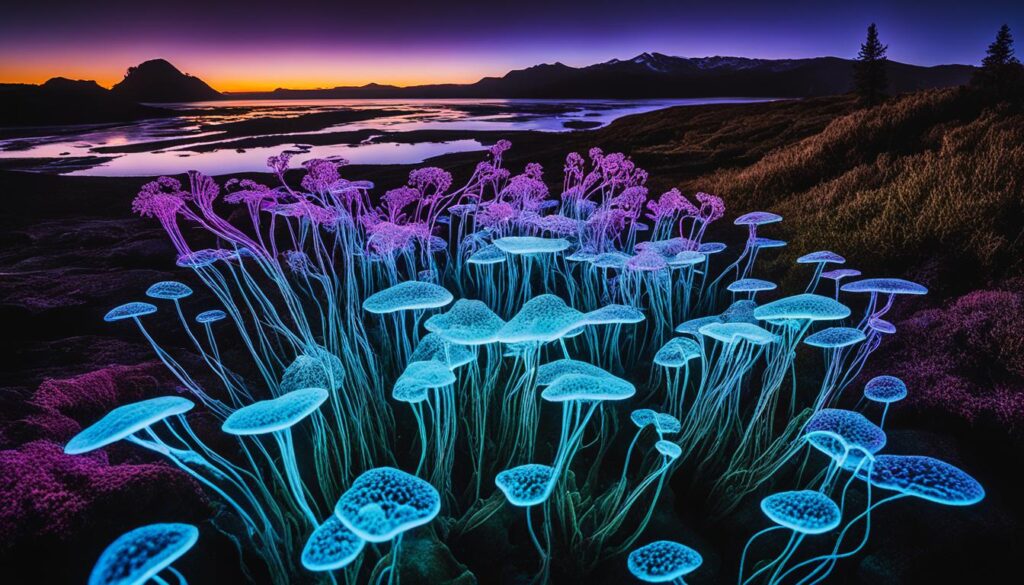
Glowing Mushrooms: Types and Distribution
Bioluminescent fungi light up the darkness in an amazing way. About 100 out of 120,000 known fungi species can glow. These mushrooms are special because of how they adapt to their environments.
Common Species of Bioluminescent Fungi
Some glowing mushrooms are more well-known than others. The Honey Mushroom glows in a greenish-yellow color. The Jack-o’-lantern mushroom shines in an orange glow with a hint of green. Mycena chlorophos stands out with its bright bluish-green light. It is mostly seen on old wood.
The Global Habitat of Glowing Fungi
Glowing mushrooms are found across the world. They like moist and dark places, often in thick woods or on fallen trees. Their habitats are key for their roles in nature. Even though they’re rare, some are found in India’s Western and Eastern Ghats. They show how unique these fungi can be.
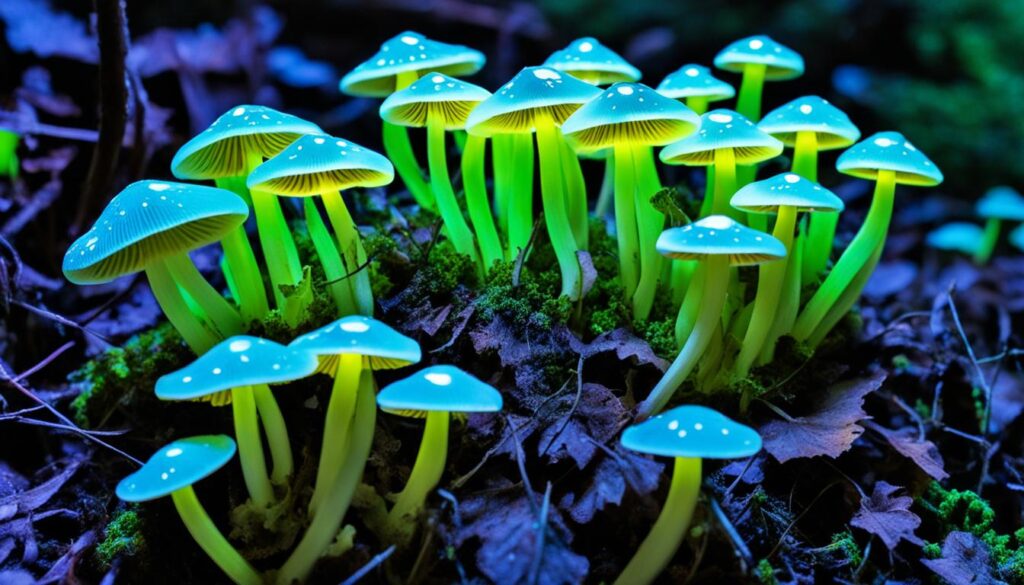
The Purpose of Bioluminescence in Fungi
Bioluminescence has an important role in fungi’s life. It helps them survive and play their part in nature. This light draws insects, helping spread spores so fungi can thrive everywhere. Knowing how glowing fungi interact with their world tells us about their survival tactics.
Theories on Attracting Insects
One main theory is that bioluminescence attracts insects. Fungi glow to catch the attention of beetles, flies, and wasps. When these bugs visit, they help spread the fungi’s spores. This forms a win-win for both, supporting a balanced ecosystem.
Predator Deterrence and Ecology
Bioluminescence can also keep predators away. The light warns that fungi might taste bad or be toxic. This helps fungi live on, even when animals are looking for a snack. As this trait appears in many fungi species, it shows their complex evolution.
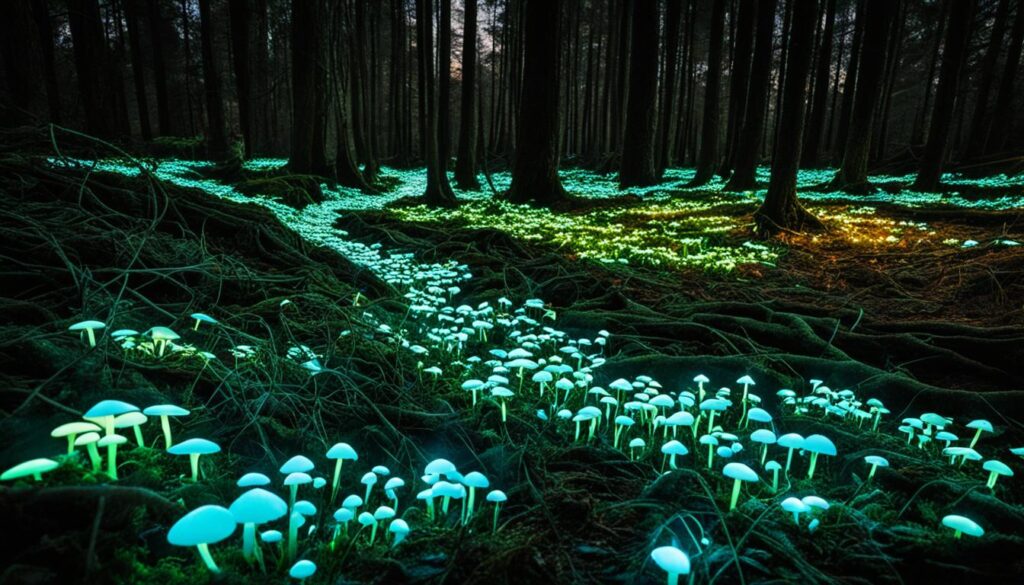
Finding Glowing Mushrooms in Nature
Looking for glowing mushrooms is both exciting and worthwhile. Start in forests with lots of dead wood or leaves. These places are perfect for finding these magical mushrooms. Humid forests around the world are the best spots. Search in areas that are moist, as moisture makes the fungi easier to see.
The perfect time to start your adventure is on dark, moonless nights or when it’s very humid. During these times, the mushrooms glow more brightly. Bringing a black light helps you spot the glowing fungi that might be hard to see otherwise.
Here are some basic mushroom spotting tips to help you find them:
- Go searching after it rains or when it’s really humid.
- Look near dead trees and leaf piles.
- Explore at night, especially when the moon isn’t out.
- Use a black light to see the glowing mushrooms better.
- Keep track of where and when you find glowing mushrooms for future trips.
Glowing mushroom sightings can change with the weather. For example, Borneo’s drought made them rare. Before the drought, many glowing mushrooms were seen. But after, only a couple were found during night walks at an ecocamp.
The Atlantic Forest in Brazil is another great place for these mushrooms. It has 27 kinds of glowing mushrooms, out of about 100 identified worldwide. Responsible visits to this diverse area help with conservation and offer a unique experience for nature lovers.
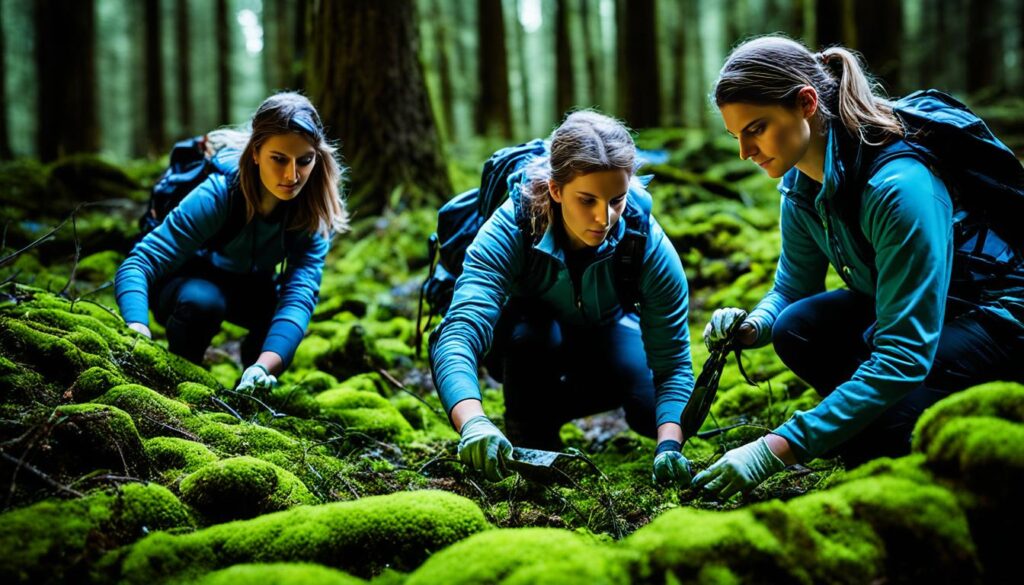
Safety and Environmental Considerations
When you go out to see bioluminescent fungi, it’s crucial to think about your safety and the environment. Being safe while exploring mushrooms makes the trip better. It also shows you care about protecting nature.
Guidelines for Safe Exploration
Here are some tips to make your adventure safe and eco-friendly:
- Dress appropriately: Choose strong shoes and clothes that suit the weather. This helps you deal with rough paths and changing weather.
- Use proper lighting equipment: A good flashlight or headlamp is essential. It helps you see at night without harming the environment with too much light.
- Respect wildlife: Stay away from animals and don’t mess with their homes.
- Follow park regulations: Listen to what local conservation groups say. They make rules to keep the place safe and green.
- Leave no trace: Take all your garbage with you. Don’t take mushrooms or plants home.
Following these tips helps keep ecosystems healthy and supports sustainable habits. Mixing your excitement for exploring with caring for the environment means others can enjoy these natural beauties later on.
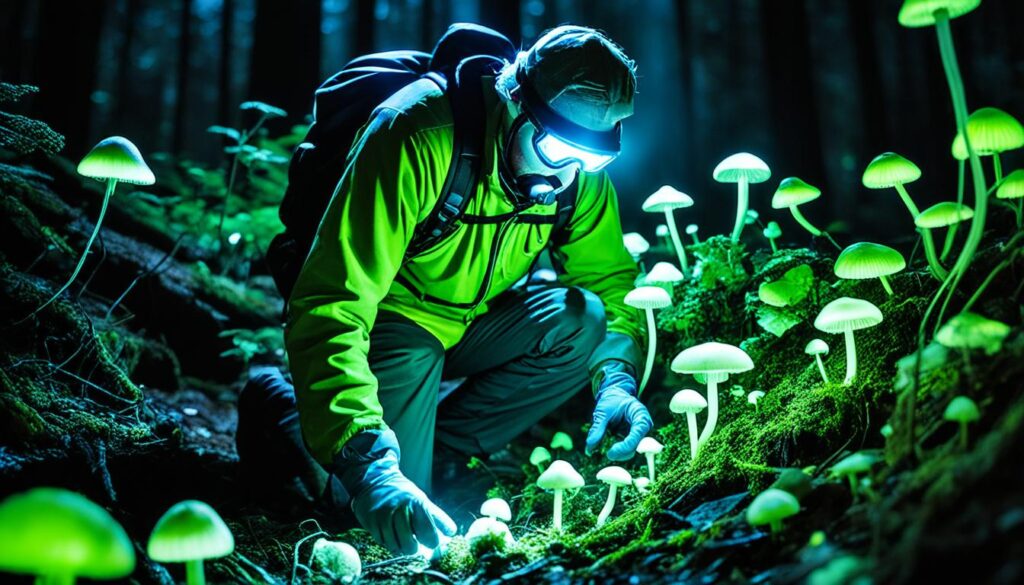
| Exploration Tips | Purpose |
|---|---|
| Appropriate Clothing | Prevention of injury and discomfort |
| Lighting Equipment | Safe navigation while minimizing light impact |
| Wildlife Respect | Protection of animals and their habitats |
| Park Regulations | Preservation of natural areas |
| Leave No Trace | Maintaining ecological balance |
Uses and Potential Applications
Bioluminescent fungi spark wonder and offer paths to innovation. Their applications go beyond looking beautiful. People are figuring out how to use this natural light in useful ways. This includes making sustainable lighting that helps our planet and our lives.
Eco-friendly Lighting Alternatives
Looking for green living options, bioluminescent fungi are promising. They could change how we light up our world. Unlike old lighting, they don’t harm the environment with carbon or waste.
We can bring beauty to cities or homes without using much electricity. This is done by using the fungi’s glow.
The next table shows important things about bioluminescent fungi and how they might light up our future:
| Aspect | Details |
|---|---|
| Natural Glow | Emits yellowish-green light at a wavelength of 520-530 nanometers |
| Species Count | Only 65 known luminescent out of approximately 85,000 fungal species |
| Diversity | Greatest in tropical regions; some found in temperate areas |
| Potential Uses | Decorative lighting, eco-friendly urban infrastructure, green design |
| Research Progress | Ongoing studies aim to integrate fungal bioluminescence into practical applications |
The future looks promising with applications of bioluminescent fungi. Shifting to sustainable lighting allows stunning visuals and helps the earth.
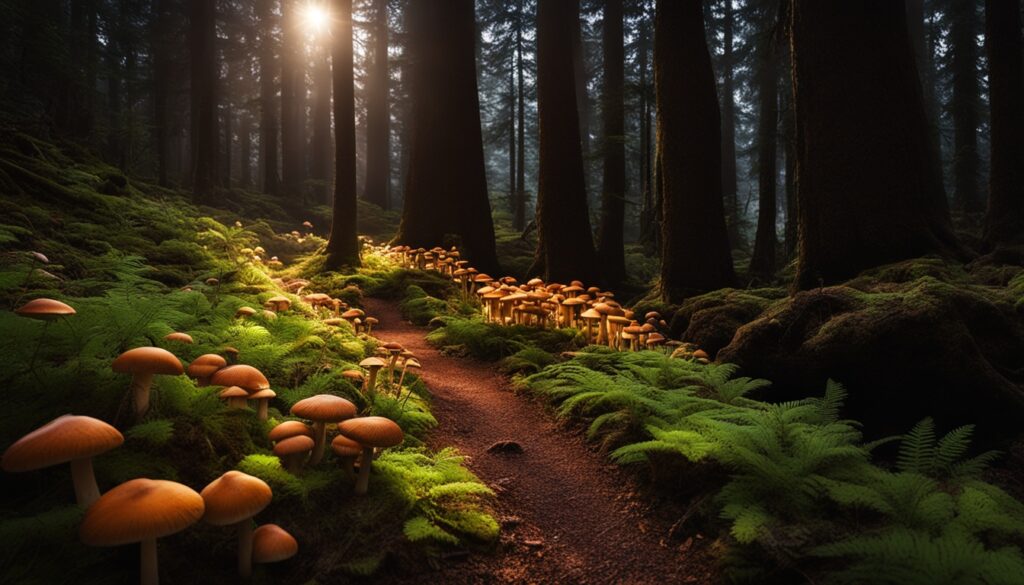
Bioluminescent Fungi in Culture and Folklore
Mushrooms have amazed people far beyond their biological traits. Through time, glowing fungi have sparked our imagination and inspired countless myths. They’re seen as symbols of the supernatural in many cultures. This shows our deep connection with nature and our search for meaning in its marvels.
Mythical Interpretations of Glowing Fungi
In Japan, glowing mushrooms guide lost souls through dark forests, acting as spiritual lights. Indigenous tribes in Central and South America see the glow as their ancestors watching over them. These stories show how mushrooms link the living to their past ancestors.
There are 81 bioluminescent fungi species out of 100,000 worldwide. Their colors range from green to blue and yellow. Australia’s ghost fungus creates an eerie glow, adding mystery to the woods. These fungi are important to nature and captivate us with their beauty.
Legends tie glowing fungi to tricking lights like the Will o’ the Wisps, leading travelers astray. Even Aristotle talked about the mysterious glow of foxfire in his time. These tales mix our curiosity with folklore, creating stories that last through the ages.

Future Research and Conservation of Bioluminescent Fungi
The world of glowing fungi fascinates many. Scientists are learning how important these fungi are. They stress the need to protect them.
Studies show these glowing fungi attract bugs to spread their seeds. This is crucial for their survival, especially in dense forests. Researchers want to know more about how these fungi interact with their surroundings.
Siberian and Moscow researchers found out what makes non-glowing mushrooms glow. They discovered glowing mushrooms have less of a certain chemical. This finding helps us understand these mushrooms better.
Scientists discovered a new glowing element in these fungi. It shines differently from other glowing life forms. This makes bioluminescent fungi unique.
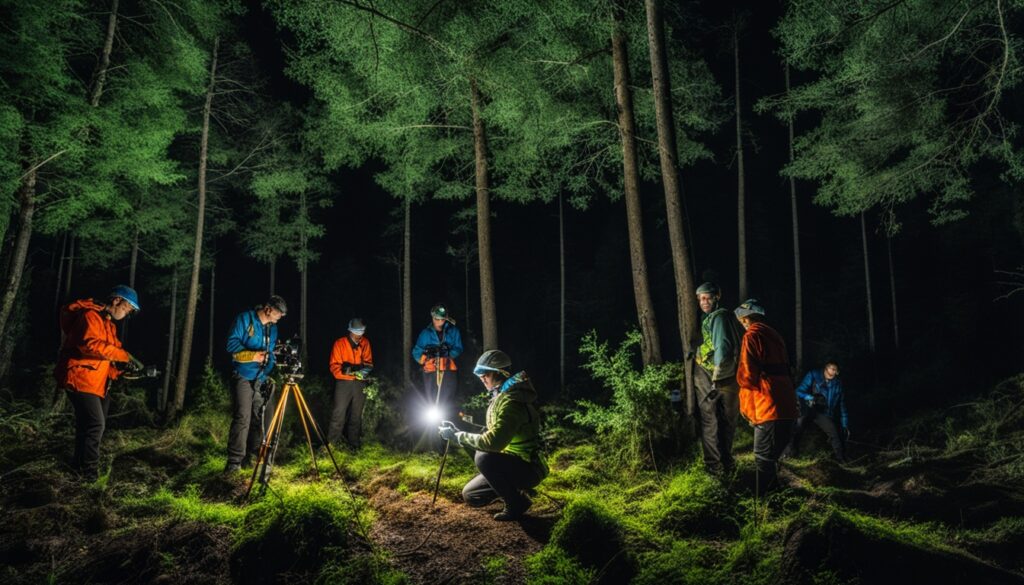
Genetic engineering might let us make plants that glow. The Glowing Plant Project aims to create glowing trees. This could change how we light our streets, mixing nature with technology.
Learning about glowing fungi is exciting. Protecting their homes is vital. Working together can help save these natural treasures. They add beauty to our world and could teach us a lot.
Conclusion
We have discovered a beautiful mix of art and science in bioluminescent fungi. Out of over 100,000 types of fungi, only 71 can glow. This summary shows their beauty and how important they are to nature.
These glowing fungi can attract insects at night. This helps them spread their spores and grow. Their ability to light up is not just for show. It plays a vital role in nature.
Research shows that these fungi have an internal clock that decides when they glow. This amazing skill shows the deep connections in our ecosystems. Understanding these glowing fungi helps us see the value of all fungi.
These natural wonders fill us with awe. We must protect their homes. Doing this ensures that future generations can also experience these magical sights. It sparks curiosity and deepens our understanding of the planet.
